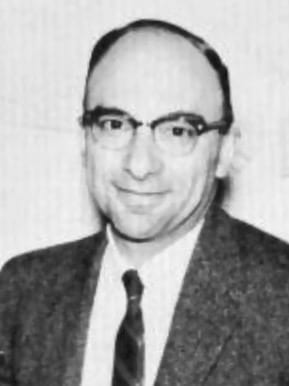David A. Rytand
David Abramson Rytand (1909-1991) was an American physician and cardiologist.
Rytand was a distinguished scholar, clinician, and teacher of Stanford University, having been involved in the university for over 65 years, and was a uniquely popular clinical teacher among the new generation of medical students and residents.
He was also a member of various organisations outside of the university, being a member of the American Association of Physicians, the American Society of Clinical Investigation, the Western Society of Clinical Investigation (President in 1954), the Western Association of Physicians (President in 1959), and the California Academy of Medicine (President in 1985).
Despite his many achievements, Rytand stated in an interview that his greatest achievements were two things; teaching students and listening to patients.
Rytand contributed to the fields of both human and veterinary medicine, and is eponymous with Rytand’s Murmur and Rytand’s Law.
Biography
- Born on November 4, 1909 in San Francisco, California
- 1929 – AB, Stanford University
- 1933 – MD, Stanford University School of Medicine
- 1954 – Chairman of the Department of Medicine, Stanford University
- 1958-1975 Inaugural Arthur L. Bloomfield Professor of Medicine, the first endowed chair in the Department of Medicine, Stanford University.
- 1975-1991 Emeritus professor, Stanford University
- 1980-1991 Director of Medical Alumni Relations Stanford University School of Medicine
- 1984 – Albion Walter Hewlett Award of the Department of Medicine
- Died on November 23, 1991 in Atherton, California
Medical Eponyms
Rytand murmur (1946)
A blowing diastolic murmur heard occasionally in patients with complete atrioventricular heart block. Best heard at the apex and often confused with mitral stenosis, the murmur is loudest when it appears early in diastole (i.e. when it coincides with the end of the early rapid filling period of the ventricle) but may appear anytime during diastole.
Observations are reported on a blowing apical murmur related to auricular activity in nine elderly but ambulatory patients with varying degrees of auriculoventricular block.
…This is another murmur which may be heard at the cardiac apex during diastole in the absence of mitral stenosis.
Rytand DA 1946: 597
Rytand was not the first to identify the presence of a diastolic murmur in patients with atrioventricular block without mitral stenosis, with Wolferth and Margolies describing its existence in 1930, and Stead and Kunkel describing it in 1939. He was, however, the first person to describe and characterise the murmur in detail.
Rytand’s Law (1951)
A law of nature which states that any exclusive benefit to an individual/group in a population results in the rest of the population being in a comparatively worse situation It was originally described in the scenario of prescribing anticoagulation after myocardial infarction.
The prognosis for a patient with myocardial infarction is worse when anticoagulants are given to someone else…
Rytand DA 1951: 210
Other eponyms
- David A. Rytand Clinical Teaching Award, Stanford University
Key Medical Attributions
One of Rytand’s most prominent contributions to the field of cardiology is proving the circus rhythm theory to be the mechanism of atrial flutter. Having been a controversial topic for nearly half a decade, Rytand acquired new data from the development of surgery on the heart to convincingly validate this theory in a study published in 1966.
Apart from cardiology, Rytand also contributed to the field of veterinary nephrology. His 1938 study on the number and size of the glomeruli in the kidneys of various mammals was a classic of the time, and is still widely cited to this day by various veterinary textbooks and research papers.
Controversies
Son of Hattie Abramson and Henry Levy, David changed his name to David Abramson Rytand [Source]. Whilst the reasoning of this is not fully known, it is speculated to be in part due to the discrimination the Jewish population faced when applying for tertiary education in private universities (see ‘Jewish Quota’).
Major Publications
- Rytand DA. The number and size of mammalian glomeruli as related to kidney and to body weight, with methods for their enumeration and measurement. American Journal of Anatomy. 1938 May; 62: 507-520.
- Rytand DA. An auricular diastolic murmur with heart block in elderly patients. American Heart Journal. 1946; 32: 579-598 [Rytand’s murmur]
- Rytand DA. Anticoagulants in coronary thrombosis with myocardial infarction. AMA Arch Intern Med. 1951; 88(2): 207-10. [Rytand’s law]
- Rytand DA. Medicine. Stanford University School of Medicine – First Hundred Years. 1959: 22-24
- Rytand DA. The Circus Movement (Entrapped Circuit Wave) Hypothesis and Atrial Flutter. Ann Intern Med. 1966; 65(1): 125-159.
- Rytand DA. Medicine and The Stanford University School of Medicine circa 1932: The Way It Was. 1984
References
Biography
- David A. Rytand, MD. Hewlett Award Presentation 1984
- Bibliography. Rytand, David A. WorldCat Identities
Eponymous terms
- Hancock EW, Creger WP, Cohn R, Krupp M. David A. Rytand Memorial Resolution. Stanford University. 1992
- Jelveh M, Berger M, Goldberg E. The genesis of the diastolic murmur of complete heart block. Phono-echocardiographic observations. Circulation. 1978; 58(4): 747-750.
- Paul MH, Rudolph AM, Nadas AS. Congenital complete atrioventricular block: problems of clinical assessment. Circulation. 1958; 18(2): 183-190.
- Robbins A, Zhang G, Cadogan M. Name that murmur. LITFL 2022
- Cadogan M. Rytand murmur. Eponym A Day. Instagram
[cite]
Lewis is an RMO at Royal Perth Hospital. He is currently interested in critical care medicine.

